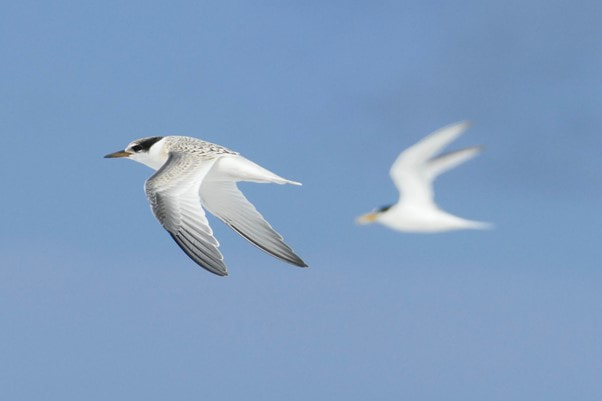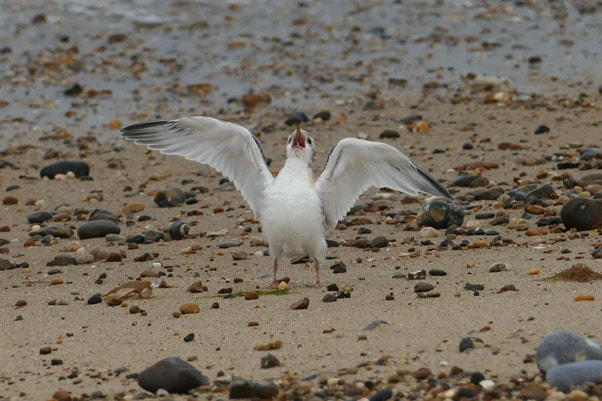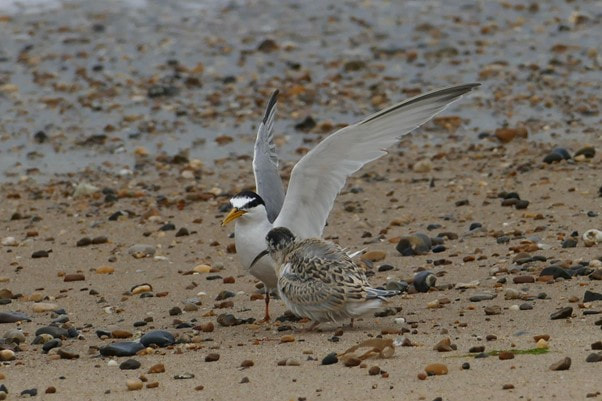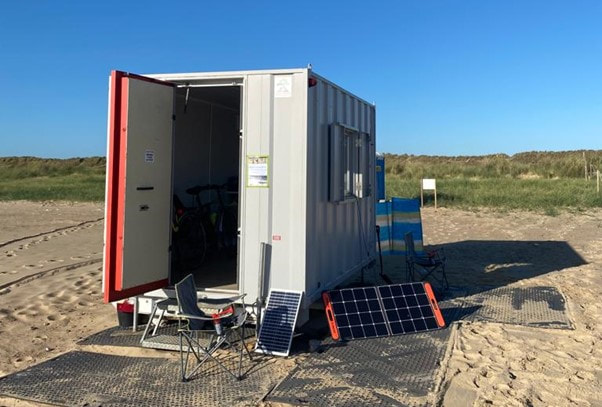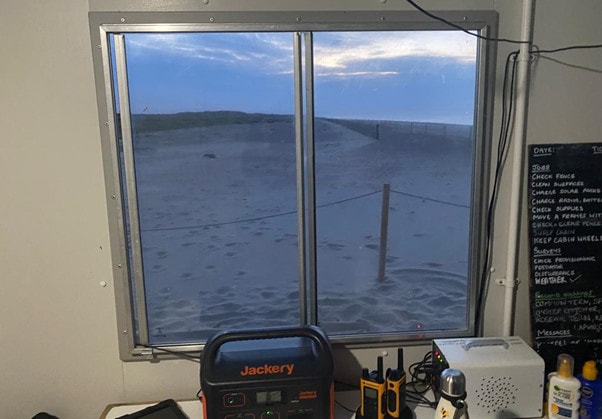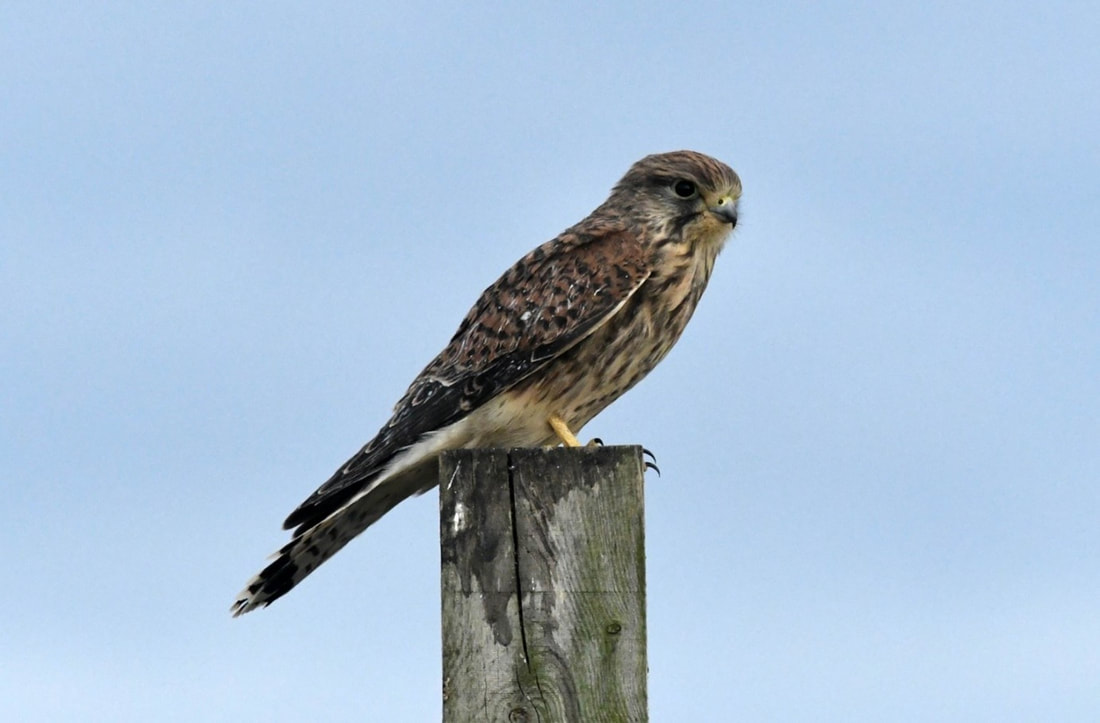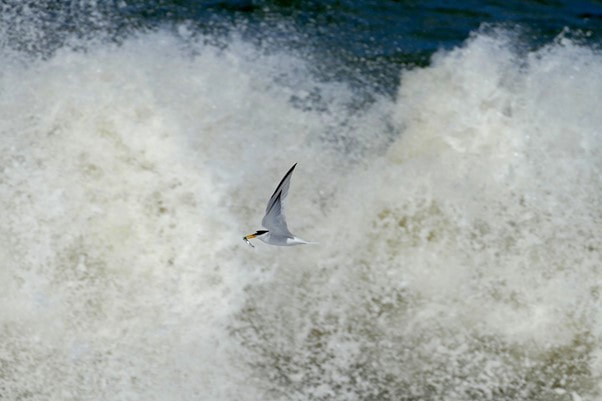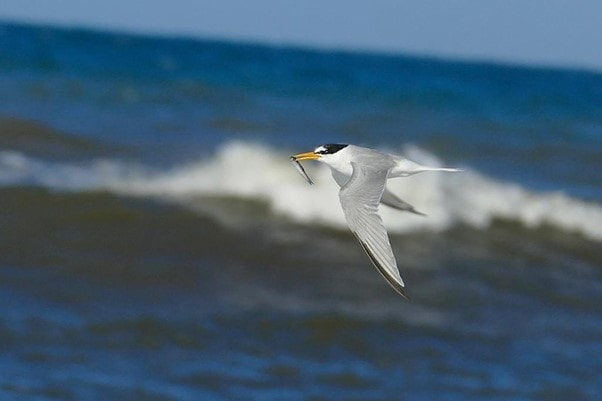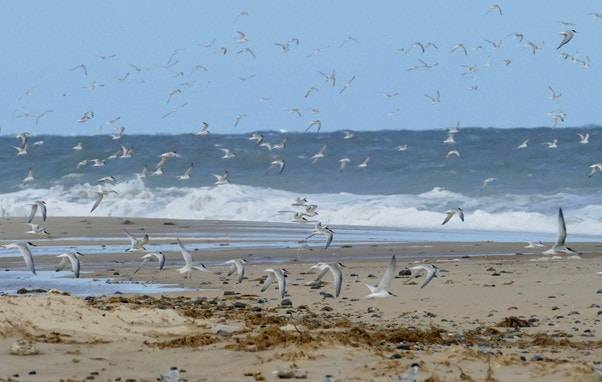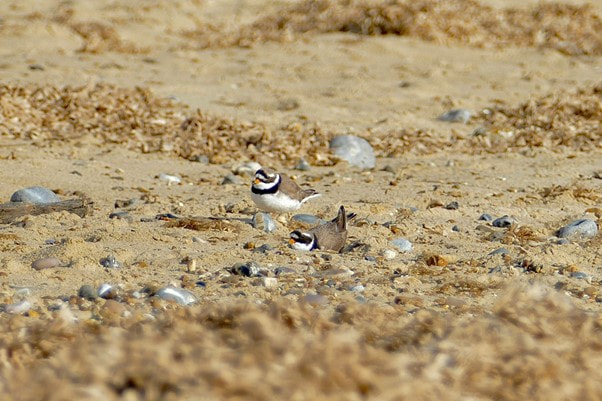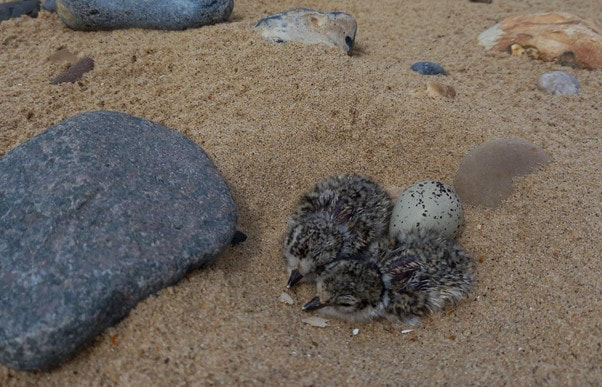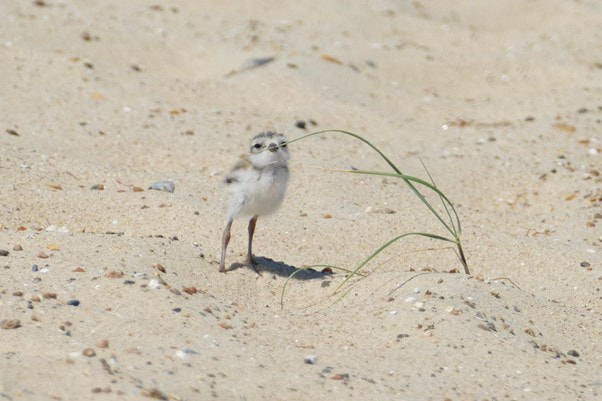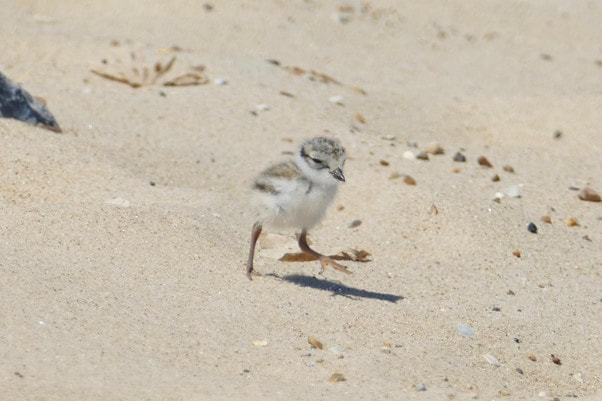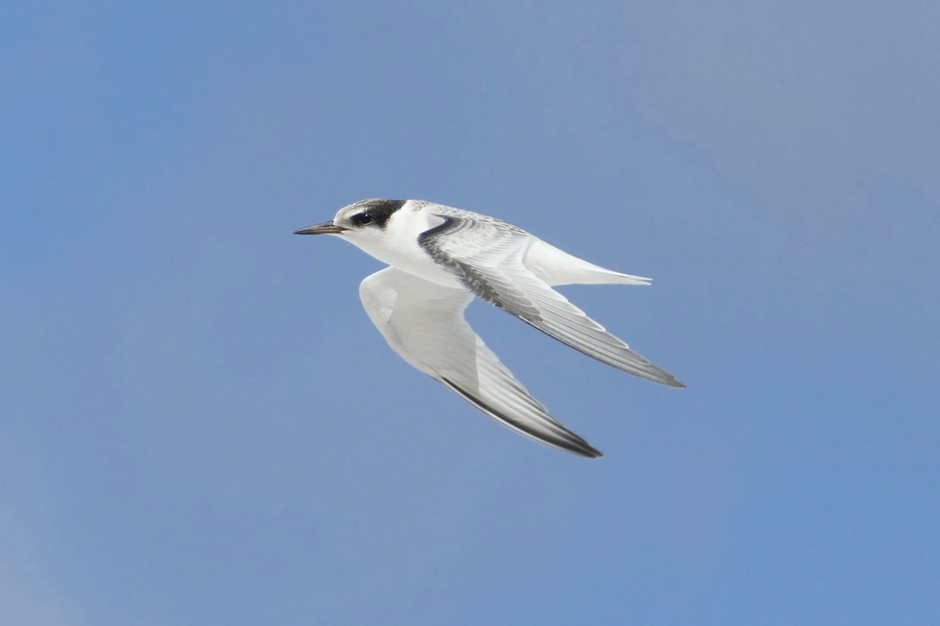|
By Will Bevan – Beach-Nesting Bird Field Officer in East Norfolk After spending last summer helping to protect the beach-nesting birds of East Norfolk, in April this year I was eagerly anticipating my return for another season. Being largely nocturnal in 2021, with my exploits as a night warden detailed on this blog, in 2022 I returned as a fully-fledged Field Officer. Our work covers three sites in East Norfolk and North Suffolk, with a team of dedicated volunteers and Field Officers working day and night over the breeding season to provide protection. Methods involve three sets of fencing (rope, electric, and poultry netting), signage, round the clock wardening, and public engagement and education on the beach and in the wider community. The focus is mainly on little terns, but this protection benefits other beach-nesting birds including ringed plovers, oystercatchers, and avocets. Little tern conservation is fraught with worry, as the odds seem to be stacked against them so heavily it is a wonder that any chicks fledge! Nesting in vulnerable spots on shingle beaches just above the tideline, they face numerous threats including human disturbance, dogs off leads, egg thieves, high tides and stormy weather (made worse by climate change), and predation from ground and aerial predators. Despite early disappointment last year with failures at two of our colony sites, mainly due to aerial predation pressure, the season ended up being a success overall with these failed birds moving to another site and re-laying, with around 137-216 fledglings leaving in mid-August. However, this was still just below the productivity target of 0.75 required to maintain or increase the population. This result also highlighted the importance of having several sites set up and ready to receive little terns which might fail elsewhere but have a second attempt at breeding in another location. With all this and stories from previous seasons in mind, it’s always a good idea not to raise hopes too high early in the season, as any number of things can go wrong. However, it was hard to not to be excited this year as the breeding got under way at the start of May. Whilst last year the terns took longer to prospect potential nest sites, eventually spreading out over all three of our protected colony areas, this year they settled in just one location. From our first egg being found on the 21st of May, just two weeks later we were counting around 300 active nests, making it the largest colony in the UK in 2022. This is compared to a peak count of 116 nests at the same site last year! The excitement started to spread as we realised that we might have a mega year on our hands. When managing several colonies there is always a difficult choice to be made because resources are limited, especially when it comes to the time of the volunteers and Field Officers. In many years the colony with the largest number of nests is prioritised as the one which receives the most protection, although a presence is still maintained at all sites. This is difficult because every breeding pair counts when it comes to little terns, with a potential for two or three fledglings which may live for two decades and have many more offspring over that lifespan. It was a relief this year to be able to put everything into one site, allowing us to have a more of a presence to deter predators and egg thieves, as well as to engage with the public on the beach. A cabin was brought down to the site for all our amenities, with solar powered lights for night shifts and a generator for charging equipment. This was a great place to get out of the weather, especially with the extreme heat we have had so far this year, as well as for observing the colony. From my experiences last year out at night in a tent, which flapped uneasily in the wind, the cabin made the night shifts almost luxurious in comparison. The first hatching date approached in mid-June with eager anticipation, as well as an increase in nerves. In previous years kestrels have been a large cause of mortality for younger chicks and fledglings, and on occasion decimated the colony. For example, a report from 2001 when the little terns nested at Great Yarmouth states that kestrels took a total of 526 chicks! Whilst we have been doing work on diversionary feeding to try and provide local kestrels with alternative food sources, a determined adult will continue to go after the terns despite our best efforts. The first tern chicks were sighted on the 14th of June and the weeks went by with only glimpses of kestrels, which luckily didn’t show interest in the colony. This did not stop the terns giving them hassle! A hobby started visiting regularly, trying to take adults and chicks, but the sheer number of little terns watching for predators and willing to mob them was enough to deter it on most occasions. This confidence lessened as the terns began to leave, and unfortunately for a few stragglers remaining towards the end of July, the hobby was much more successful. High spring tides can also be a challenge for the little terns, especially combined with strong north and easterly winds coming off the North Sea. Nests can be moved a small amount at a time, so long as we make sure to replicate the pattern of stones around the nest, but if the tide is high enough it can wipe out a large percentage of the colony. Luckily, we had no incidents where the nests were at risk this season, with the highest tides not coinciding with strong winds. Public engagement on the beach was also very positive this year, and this is a key part of our work in making people more aware of beach-nesting birds on the coast and educating them about responsible dog walking. I had some great conversations with those who knew about the birds already and many who were seeing them for the first time, and it was rewarding to be able to use scopes to allow adults and children to see the chicks up close. Dog owners were more than happy to put their pets on leads, showing that effective signage and friendly engagement can lead to positive behavioural changes. Little terns also need plentiful stocks of small fish in shallow water near to the colony, and this seemed to be no problem for them this year as they were constantly flying to and from the sea with fish for their growing young. It seemed like the stars aligned for this year’s season, and the full scale of what the terns had accomplished became apparent as the fledgling numbers built up on the shore. Our fledgling count was a whopping 585 on the 14th of July, and this is the lower estimate, with a potential for between 650- 700 leaving the site overall. This year was also productive for our ringed plovers, with a total of 17 nests and 18-25 fledged across our sites. Usually, plover nests are spread out along the coastline, but many choose to nest within our fencing as they are much less likely to be disturbed. For rogue pairs outside our main fence, we can put up some posts with a bit of rope and cross our fingers, and this year we had eggs successfully hatching from just such a nest! We also had two oystercatchers and three avocets fledge from our Suffolk site. Another joy of the season was watching a pair of plover chicks grow up into fledglings which had become habituated to our presence around the cabin, and on a night shift they often would run around my feet as I sat out in a camping chair! In a year when there has been lots of bad news, especially with bird flu and how it has affected our struggling bird populations, it is a relief to be able to share something positive. Although every year is different, we are all hoping that this is the beginning of a trend where we can start stabilising or even increasing the numbers on the East Coast and the U.K. Once again this has only been possible thanks to a truly incredible team of volunteers and staff, an extremely supportive local community, and the funding and support of Natural England and Great Yarmouth Borough Council.
3 Comments
Murray Orchard
25/8/2022 15:28:50
This is truly fantastic and heartening news in such an otherwise depressing year for our seabirds due to bird flu. With the terrible effects on our Sandwich Terns it’s wonderful to hear that our Little Terns have done so well. I get the impression that they have done ok elsewhere too - even our handful of birds in Kent. It seems their lifestyle somehow gives them greater resilience to bird flu?? Not heard of them being affected….
Reply
25/8/2022 19:52:50
Only a few words to describe the 2022 Little Tern breeding season - truly exceptional and well done to all wardens and volunteers. If I only lived nearer. 👏👏 !!
Reply
Paul Douch
26/8/2022 18:31:47
A spot of cheer among the gloom of avian-flu. Well done to the team. Good words and great pics, Will!
Reply
Leave a Reply. |
Archives
April 2024
Categories
All
Photo credits: Oystercatcher by Katie Nethercoat (rspb-images.com)
LOTE Logo credits: Saskia Wischnewski |

